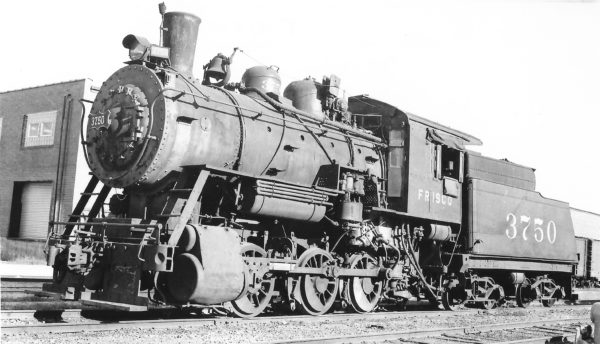Monthly Archives: December 2017
Caboose 1130
VO-1000m 215

VO-1000m 215 at Springfield, Missouri in June 1970 (Mac Owen).
This is the west end of the locomotive service tracks area just southeast of the Diesel Shop at Springfield Yard. Under construction overhead is the new overpass for North Kansas Avenue. Just to the east, beyond the bridge piers and I-beams, is the newly constructed covered service tracks area. Above the locomotive’s cab, in the distant shadows, note the upper wall vents, roof support trusses and hanging area lights of the service tracks shed.
VO-1000 215 was originally built by the Baldwin Locomotive Works in Eddystone, Pennsylvania. It entered service with the Frisco on January 15, 1944. Later, it was one of three units (205, 210, 215) sent to General Motors Electro-Motive Division (EMD) for repowering in 1957. At the firm’s La Grange, Illinois plant it was repowered on March 26, 1957. Thus the modified or “m” model designation. In 1959 six additional VO-1000 units (200-204, 206) were also rebuilt. During rebuilding the latter group were also equipped with multiple unit (MU) controls.
Behind the subject locomotive is an unidentified standard VO-1000. At this date it is one of fifteen possibilities (208, 211, 212, 214, 217, 218, 219, 222, 224, 226, 231, 232, 234, 236 or 237). The other un-repowered VO-1000 and all the DS-4-4-1000 units had been retired. Visible in the distance on Service Track 4 between the switch engines is one of nine unidentified 30 series (30-34, 36-39 – 35 was retired in 1969 before the photograph) F7A units.
The view is looking northeast.
Special thanks to Mark Davidson.
Instruction Car 50
GP7 630

GP7 630 at Birmingham, Alabama in October 1967.
The locomotives are in the Mechanical Department’s locomotive service tracks area at East Thomas Yard. The locomotives are sitting southwest of the turntable and former steam engine roundhouse converted to diesel shop. The building in the background is the crew locker and shower room. Across the parking lot to the northeast is the yard office and tower.
GP7 630 was built on February 20, 1952 and delivered to the railroad on March 1, 1952. This unit was among 96 similar units built at EMD’s Cleveland, Ohio plant. The Frisco’s other 32 GP7L units (128 in total) were built at EMD’s plant in La Grange, Illinois. The unit would ultimately be repainted in the mandarin orange and white scheme. It was retired on December 18, 1979. This locomotive was among the last 20 GP7L units on the roster when the remaining group was sold to Precision National Company (PNC). It was ultimately scrapped.
Behind the subject locomotive is an unidentified NW2 phase V unit (SLSF 260-265). The significant spotting features in this view include the single taper hood top to the cab front and the absence of side sill frame falsies inboard of the step wells. Frisco’s other NW2 units were phase IV (SLSF 250-259). These units featured a two-step hood top (taper then horizontal) to the cab front and had side sill frame falsies, downward extensions, inboard of the step wells.
We can narrow the identification of this specific locomotive to most likely unit 262, 263 or 265. Photographic evidence indicates units 260 and 264 had small flagging equipment boxes on the walkway below the front radiator intake. Unit 261 spent almost its entire life assigned to Wichita, Kansas.
The view is looking north.
Special thanks to Mark Davidson.








